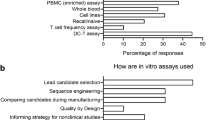Abstract
This document highlights some relevant factors in the assessment of immunogenicity risk of fusion protein therapeutics. Our aim is to highlight specific risks associated with this type of molecule, while also aligning with general risk assessment factors, through a hypothetical case study, where the therapeutic molecule of interest is a Receptor-Fc Fusion protein (RFF) expressed within a typical manufacturing process in Chinese Hamster Ovary Cells (CHO). Given that the components are comprised of endogenous sequences, the risk of developing an ADA response to this molecule is generally considered to be low. However, the consequences of such an immune response may be more severe, specifically, if there is cross reactivity with the endogenous receptor, inducing cell lysis, or if any ADA act as an agonist to trigger receptor signaling. The risk factors described below are not meant to provide a comprehensive list, but rather a framework for factors that should be considered. Immunogenicity risk is difficult to quantify and relies on a comprehensive analysis of both product and patient-related factors. The goal is not necessarily to quantify risk, but rather to demonstrate an understanding of factors that may pose a risk, implement a strategy to minimize risk factors and then align overall risk with a bioanalytical immunogenicity monitoring strategy. The consequences resulting from unexpected outcome will likely depend on severity and impact on patient safety. An immunogenicity risk assessment is an ongoing and continuous process throughout clinical development with the goal of maximizing the safety of patients.
Similar content being viewed by others
References
Chamberlain P. Effective presentation of immunogenicity risk assessments and related data in regulatory dossiers. Bioanalysis. 2019.
FDA. Guidance for Industry, Immunogenicity Assessment for Therapeutic Protein Products. 2014.
Enbrel® (etanercept) Solution for Subcutaneous Use [Internet]. 2012. Available from: https://www.accessdata.fda.gov/drugsatfda_docs/label/2012/103795s5503lbl.pdf.
Roopenian DC, Akilesh S. FcRn: the neonatal fc receptor comes of age. Nat Rev Immunol. 2007;7(9):715–25.
ORENCIA (abatacept) for injection, for intravenous use for subcutaneous use [Internet]. 2017. Available from: https://www.accessdata.fda.gov/drugsatfda_docs/label/2017/125118s209lbl.pdf.
NULOJIX (belatacept) for injection, for intravenous use [Internet]. 2017. Available from: https://www.accessdata.fda.gov/drugsatfda_docs/label/2017/125288s070lbl.pdf.
Nplate™ (romiplostim) for subcutaneous injection [Internet]. 2008. Available from: https://www.accessdata.fda.gov/drugsatfda_docs/label/2009/125268s0026lbl.pdf.
ARCALYSTTM (rilonacept) Injection for Subcutaneous Use [Internet]. 2008. Available from: https://www.accessdata.fda.gov/drugsatfda_docs/label/2008/125249lbl.pdf.
Brezski RJ, Kinder M, Grugan KD, Soring KL, Carton J, Greenplate AR, et al. A monoclonal antibody against hinge-cleaved IgG restores effector function to proteolytically-inactivated IgGs in vitro and in vivo. MAbs. 2014;6(5):1265–73.
Scapin G, Yang X, Prosise WW, McCoy M, Reichert P, Johnston JM, et al. Structure of full-length human anti-PD1 therapeutic IgG4 antibody pembrolizumab. Nat Struct Mol Biol. 2015;22(12):953–8.
Wang X, Mathieu M, Brezski RJ. IgG fc engineering to modulate antibody effector functions. Protein Cell. 2018;9(1):63–73.
Jacobsen FW, Stevenson R, Li C, Salimi-Moosavi H, Liu L, Wen J, et al. Engineering an IgG scaffold lacking effector function with optimized Developability. J Biol Chem. 2017;292(5):1865–75.
Silva JP, Vetterlein O, Jose J, Peters S, Kirby H. The S228P mutation prevents in vivo and in vitro IgG4 fab-arm exchange as demonstrated using a combination of novel quantitative immunoassays and physiological matrix preparation. J Biol Chem. 2015;290(9):5462–9.
Harmonisation ICo. ICH quality implementation working group, points to consider (R2); ICH-endorsed guide for Q8/Q9/Q10 implementation. 2011.
Alt N, Zhang TY, Motchnik P, Taticek R, Quarmby V, Schlothauer T, et al. Determination of critical quality attributes for monoclonal antibodies using quality by design principles. Biologicals. 2016;44(5):291–305.
Immunogenicity Testing of Therapeutic Protein Products — Developing and Validating Assays for Anti-Drug Antibody Detection, Guidance for Industry [Internet]. 2019. Available from: https://www.fda.gov/media/119788/download.
Starcevic Manning M, Kroenke MA, Lee SA, Harrison SE, Hoofring SA, Mytych DT, et al. Assay signal as an alternative to titer for assessment of magnitude of an antidrug antibody response. Bioanalysis. 2017;9(23):1849–58.
Lagasse HAD, Hengel H, Golding B, Sauna ZE. Fc-fusion drugs have FcgammaR/C1q binding and signaling properties that may affect their immunogenicity. AAPS J. 2019;21(4):62.
Sazonovs A, Kennedy NA, Moutsianas L, Heap GA, Rice DL, Reppell M, et al. HLA-DQA1*05 carriage associated with development of anti-drug antibodies to infliximab and Adalimumab in patients with Crohn's disease. Gastroenterology. 2019.
Voskuil MD, Bangma A, Weersma RK, Festen EAM. Predicting (side) effects for patients with inflammatory bowel disease: the promise of pharmacogenetics. World J Gastroenterol. 2019;25(21):2539–48.
Rath T, Baker K, Dumont JA, Peters RT, Jiang H, Qiao SW, et al. Fc-fusion proteins and FcRn: structural insights for longer-lasting and more effective therapeutics. Crit Rev Biotechnol. 2015;35(2):235–54.
Acknowledgments
We thank Valerie Quarmby (Genentech, Inc.) and Sally Fischer (Genentech, Inc.) for their careful review of this manuscript.
Author information
Authors and Affiliations
Corresponding author
Additional information
Guest Editor: Johanna Mora
Publisher’s Note
Springer Nature remains neutral with regard to jurisdictional claims in published maps and institutional affiliations.
Rights and permissions
About this article
Cite this article
Sperinde, G., Montgomery, D. & Mytych, D.T. Clinical Immunogenicity Risk Assessment for a Fusion Protein. AAPS J 22, 64 (2020). https://doi.org/10.1208/s12248-020-00447-y
Received:
Accepted:
Published:
DOI: https://doi.org/10.1208/s12248-020-00447-y



